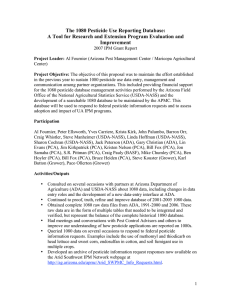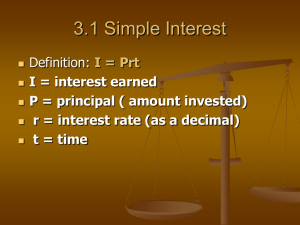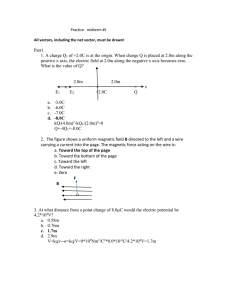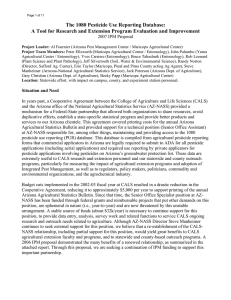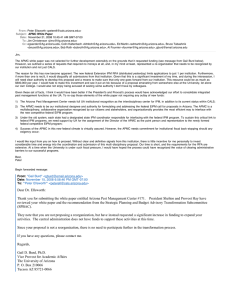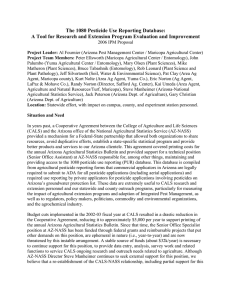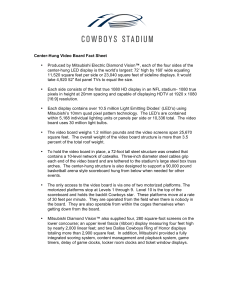A Partnership for Enhancing Extension Program Success:
advertisement
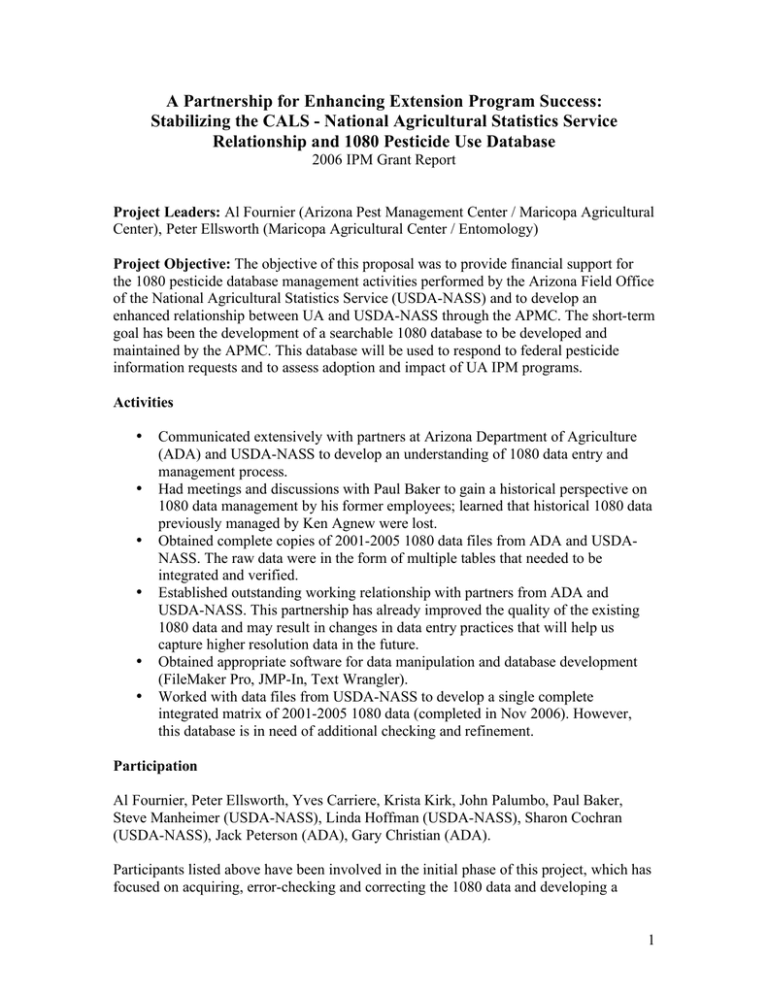
A Partnership for Enhancing Extension Program Success: Stabilizing the CALS - National Agricultural Statistics Service Relationship and 1080 Pesticide Use Database 2006 IPM Grant Report Project Leaders: Al Fournier (Arizona Pest Management Center / Maricopa Agricultural Center), Peter Ellsworth (Maricopa Agricultural Center / Entomology) Project Objective: The objective of this proposal was to provide financial support for the 1080 pesticide database management activities performed by the Arizona Field Office of the National Agricultural Statistics Service (USDA-NASS) and to develop an enhanced relationship between UA and USDA-NASS through the APMC. The short-term goal has been the development of a searchable 1080 database to be developed and maintained by the APMC. This database will be used to respond to federal pesticide information requests and to assess adoption and impact of UA IPM programs. Activities • • • • • • Communicated extensively with partners at Arizona Department of Agriculture (ADA) and USDA-NASS to develop an understanding of 1080 data entry and management process. Had meetings and discussions with Paul Baker to gain a historical perspective on 1080 data management by his former employees; learned that historical 1080 data previously managed by Ken Agnew were lost. Obtained complete copies of 2001-2005 1080 data files from ADA and USDANASS. The raw data were in the form of multiple tables that needed to be integrated and verified. Established outstanding working relationship with partners from ADA and USDA-NASS. This partnership has already improved the quality of the existing 1080 data and may result in changes in data entry practices that will help us capture higher resolution data in the future. Obtained appropriate software for data manipulation and database development (FileMaker Pro, JMP-In, Text Wrangler). Worked with data files from USDA-NASS to develop a single complete integrated matrix of 2001-2005 1080 data (completed in Nov 2006). However, this database is in need of additional checking and refinement. Participation Al Fournier, Peter Ellsworth, Yves Carriere, Krista Kirk, John Palumbo, Paul Baker, Steve Manheimer (USDA-NASS), Linda Hoffman (USDA-NASS), Sharon Cochran (USDA-NASS), Jack Peterson (ADA), Gary Christian (ADA). Participants listed above have been involved in the initial phase of this project, which has focused on acquiring, error-checking and correcting the 1080 data and developing a 1 searchable data matrix for queries. As the database is finalized, it is expected that more faculty will be engaged. Outcomes / Current Status • • • • • Five years of 1080 data (2001-2005) have now been developed into a workable integrated database available for pesticide information queries. While still not perfect, these data have been significantly corrected and improved from the source data. Each interaction with the data will result in continued refinements. The process of working with the raw data files from ADA and USDA-NASS has been documented and refined through successive iterations of data management. The experience we have gained will make future expansion and additions to the existing data more expeditious. The quality of the1080 data has been significantly improved directly through the interactions between the APMC and USDA-NASS. Specific requests by the APMC have resulted in a more thorough review of the 1080 data by USDANASS, which has resulted in new edit checks and improved database structure. Relationships have been established between the APMC and partners at ADA and USDA-NASS that will help ensure continued access to these data, as long as funding is available to support data entry and management. The preliminary 5-year 1080 database we have developed has already proved quite useful: o Data are now available and will facilitate rapid responses to future pesticide information requests from EPA. o For example, Peter Ellsworth was able to access the 1080 data to respond (multiple times) to EPA requests for information on Arizona endosulfan use. The availability of these data made it easy to generate real world statistics and graphs related to endosulfan use. In all likelihood, without this data-based response to EPA, our current use patterns for endosulfan in cotton would have already been curtailed or eliminated altogether. Endosulfan has been documented among the top three active ingredients that cotton growers use in the control of a wide array of pests including whiteflies and Lygus. Examples of questions posed by EPA: How much and how often is endosulfan used in cotton through aerial application? What are the average rates required when used alone or in mixture with other crop chemicals? What are the major uses and targets for this compound in cotton? What are the maximum number of acres that an applicator covers per day? What would be the impact of lowering the maximum labeled rate to 0.75 lbs ai / A? How many pilots, planes and aerial application businesses are there in Arizona? How do they receive their training / education? How many mixer / loaders are associated with a typical aerial application? 2 How would Arizona enforce their proposed daily limit of 900 lbs ai / day? The expected outcome of this activity is a precedent-setting reregistration and label change that would permit cotton growers in Arizona access to this valuable active ingredient with new daily application limits. At the same time, by imposing limits based on real practice, the resulting use pattern should better protect the health and safety of aerial applicators, mixers and loaders. o The database has been used to develop some preliminary data on the adoption of UA Extension guidelines for neonicotinoid use in cotton and vegetable crops. John Palumbo will present these data at the 2006 Annual Meeting of the Entomological Society of America (ESA) and Peter Ellsworth will present these data at the 4th International Bemisia Conference (12/06). This initial query will be expanded and will form the basis of analysis work by Al Fournier, Peter Ellsworth, John Palumbo and Yves Carriere for a 2005 Western Regional IPM Competitive Grant. Leveraged Resources, Continuing Need • • • • • • A 2005 Western Regional IPM Competitive grant related to IPM program assessment provides significant salary support to Al Fournier related to his1080 work. Leveraged funds to support USDA-NASS 1080 data work come from various sources. Due to the APMC grant funds, Steve Manheimer, Director of the USDANASS Arizona Field Office, has devoted federal staff to help review 1080 data and to provide as needed help with APMC 1080 data requests. These federal resources would not have been provided without the support of the APMC grant funds. In an effort to keep the Senior Office Specialist employed, USDA-NASS has provided more than $7,000 in federal funds to offset the shortfall in funding. The Arizona Department of Agriculture (ADA), who is also a primary data user, has provided some additional funding to USDA-NASS. However, without the APMC grant, there is no other agency or enterprise that could make up the $8,000 shortfall and the position of Senior Office Specialist will be eliminated. Without this position, all 1080 work performed by USDA-NASS will cease. UA faculty members, ADA personnel, and USDA-NASS staff have contributed significant time and energy to this new partnership and continue to make themselves available as questions and concerns arise. The 1080 database is very useful to the APMC, the ADA and to specific commodity groups that need to provide supporting data to federal and state agencies regarding pesticide product use. USDA-NASS is involved because of their database expertise. While they are willing to leverage their limited resources to serve Arizona agriculture, in the current funding climate they remain reliant on the APMC grant. Even prior to the funding of this proposal in 2006, Peter Ellsworth and Al Fournier had discussions with Colin Kaltenbach, Alan Ker, and members of the agricultural industry to garner support for AG Statistic’s 1080 data management 3 position. So far these efforts to obtain additional leveraged funds for these efforts have been unsuccessful. For the 1080 data management position at USDA-NASS to become sustainable in the long-term, and to provide continued access to these important data for program assessment and hypothesis testing, we feel it will be important to establish a more long-term funding commitment from UA and other end-users. 4
